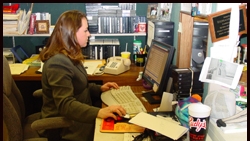KWTX speeds up with Quantel sQ

Every journalist has access to every story on the server from their desktops with Quantel’s sQView, which runs alongside ENPS.
KWTX and its satellite station KBTX serve the towns of Waco, Bryan, Killeen and Temple in central Texas. The two stations have a potential audience of more than 310,000 households, with the world's largest military facility, Ft. Hood Army Base, on their doorstep, as well as more than 60,000 college students enrolled at nearby Texas A&M University and Baylor University.
Specifying the system
By 2004, the technology KWTX and KBTX were relying on was becoming unreliable and uneconomical to maintain — and also, too slow in getting the news to air and keeping it fresh with every newscast. KWTX's existing system, based around Beta SP tape, was simply not up to the new challenges.
One of the station's big objectives was to be able to quickly and efficiently fresh-en up video. The station wanted a system that would allow it to re-edit stories from show to show — simply and quickly. That means having faster access to material without cueing or loading. Tape is too slow to support the kind of show it wanted to put on, so its first requirement of the new system was to have nonlinear access to all material.
The station looked closely and critically at all the integrated news systems on the market, but most of them had too many separate boxes and too many jumps from one application to another. Close integration with KWTX's ENPS newsroom system was also vital, and the system would need to be able to run under the control of the Sundance automation system.
Taking the plunge
The professional video industry's #1 source for news, trends and product and tech information. Sign up below.
KWTX visualized one big virtual newsroom across three locations in a non-discriminating environment that would provide equal access to all news video from everywhere.
The station chose the Quantel sQ system for a number of reasons. First, it was much closer to being a “newsroom system in a box” — an integrated news environment that would be easy for everyone to learn and use.
The system
Second, the station's 20-year-long relationship with the company's still stores, DVEs and Paintbox proved the company's dependability. Third, KWTX felt that the company treats video the way it ought to be treated. Editors who had evaluated competing systems loved the intuitive simplicity of the company's editing and video handling. Cost was also a factor, but the company worked with the station on giving it a competitive price.
The central apparatus room features legacy Quantel Picturebox still stores and a Paintbox Express (in the foreground) alongside the new sQ server, editing hardware and new-generation Paintbox.
To meet the ‘single virtual newsroom’ paradigm, the sQ system is spread across three locations, but it enables everyone everywhere to look at all material wherever it is held.
The station's headquarters in Waco, with upwards of 30 journalists, editors and photographers, has the biggest equipment roster. At its heart is a six-port sQ server with 90 hours of MPEG-2 storage. This supports eight sQView browse applications on journalists' desks in the newsroom, four of the powerful sQEdit applications in the craft edit rooms, an sQEdit Plus in the promos/ads suite and a new Paintbox in graphics.
Alongside all the new Quantel systems in the equipment room are two Quantel Pictureboxes (installed in the early 90s), which are still in daily service fulfilling KWTX's stills presentation needs. The sQView applications share desktops with the journalists' ENPS workspaces, with Sundance Digital's NewsLink automation handling ingest, satellite scheduling and playout.
KBTX in Bryan has a four-port sQ server, with 20 hours of storage supporting four sQView and three sQEdit applications, while the Killeen bureau has just two sQEdit systems.
Connecting Waco, Bryan and Killeen in order to provide the seamless interchange of material, while containing costs, required the ingenuity of the station's chief engineer, Larry Brown. The obvious way to go was to rent bandwidth on fibre, but the high cost of this option led Brown to look at the possibility of adapting their existing DS3 microwave infrastructure.
The station successfully managed to tie a new 5.8MHz carrier onto the existing 7GHz microwave system — particularly impressive because the microwave link is not line-of-sight, but a three-hop system.
It just works
Rounding out the new setup, archiving is done to videotape, with the Sundance Digital automation likely to be extended to provide asset management of the archive in the not-too-distant future.
So how's the new system doing? The first clue comes in the on-air control room, where an air of calm, quiet and unhurried confidence reigns — even in the moments immediately prior to going on-air. Meanwhile, in the newsroom, it's clear that the Quantel interface has already become second nature to the newsroom staff, and on any given day you are nearly as likely to see a news anchor or chief engineer sitting at the controls as the journalists or editors; everyone has been trained in the system's use.
But the real proof of the system is in the viewers' response. KWTX has begun to grow its audiences again — in particular, the young male viewers, with fast-moving video and lots more sports. KWTX has been able to turn around the important local college football highlights much more quickly and has been able to package them more attractively on the new sQEdit Plus system.
George Loveless is a broadcast technology writer.
